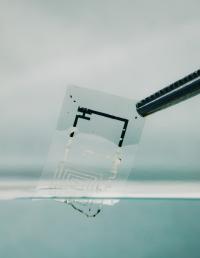Recent research by University of Illinois in conjunction with Northwestern University and Tufts University has yielded a novel technology of biodegradable electronics that could cause major shifts in consumer and medical electronics.
 A biodegradable integrated circuit during dissolution in water. Credit: Beckman Institute, University of Illinois and Tufts University
A biodegradable integrated circuit during dissolution in water. Credit: Beckman Institute, University of Illinois and Tufts University
The innovative class of electronics conceived by the researchers can dissolve in water and fluids present in the human body.
According to John A. Rogers, Professor of Engineering at University of Illinois and lead researcher of the study, the key focus since the inception of the electronics industry has been to develop devices that are long lasting. However, devices that are designed to be physically obliterated in a phased and controlled manner could open up new vistas.
Referred to as transient electronics, the new class of devices have three significant potential applications. One is their use in medical implants for diagnostic and therapeutic purposes which dissolve and get absorbed by the bodily fluids once they are past their utility. The second application is in environmental sensors which prevent ecological impact as they disintegrate over a period of time. Third is the application in consumer electronic devices, especially cell phones that are frequently updated to newer versions leaving a pile of electronic waste in their wake. If these devices incorporate the new class of electronics, there would be significant reduction in electronic waste. The devices are made from extremely thin sheets of silicon and are contained within silk casings. The rate of dissolution of the devices is determined by the structure of the silk.
The researchers have built transient diodes, solar cells, photo detectors, temperature sensors, strain sensors, transistors, antenna and simple digital cameras.